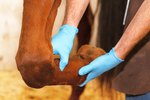
For centuries, horse owners have used poultices on their equines to relieve soreness and inflammation. These tried-and-true methods are still in use today, incorporating modern medications and bandage materials. Equine poultice techniques usually include bandaging, which you should practice ahead of time. If you don't have experience in properly bandaging a horse's legs, you can end up causing more harm than good.
Materials
Poultices generally consists of clays that help reduce swelling or draw out infections. They often contain medication or herbs to improve effectiveness. You can make a homemade poultice out of Epsom salt and wheat bran for drawing out hoof abscesses, using 1 part salt to 2 parts bran. Many equine veterinarians recommend the medicated poultice sold under the brand name Animalintex, since it can be cut to size. You'll need bandages to hold most poultices in place. Baby diapers make good choices for covering a hoof poultice. You will also need scissors, duct tape and gauze. Certain types of poultices require plastic wrap or cellophane. Apply poultices with gloves to avoid a huge mess.
Hot or Cold?
Hot poultices help draw out pus, while cold poultices reduce inflammation. For heating, a poultice such as Animalintex must be placed in boiling water -- which has cooled a bit -- becoming saturated before use. Once you open a container of clay poultice, be sure to close it carefully, as an open container quickly dries out. Horse Journal recommends putting the amount needed in a plastic bag and heating it in the microwave. For a cold clay poultice, place the bag in the freezer for about a half an hour. Before putting the poultice on the horse's leg, clean the leg thoroughly, then wet it down with either warm or cold water. After applying the poultice, bandage the legs. Remove the bandage within 24 hours.
Sweat Bandage
Sweat bandages help reduce fluid buildup in the legs of horses suffering from strains or other injuries and confined to a stall for recuperation. The American Association of Equine Practitioners recommends applying a poultice to the legs, then covering the legs with light plastic wrap or cellophane and cotton bandaging. The sweat bandage reduces inflammation and helps remove excess fluid from the leg. Don't use a sweat bandage on open wounds.
Hoof Abscesses
Hoof abscesses are extremely painful for your horse. Poulticing the hoof helps draw out the pus, offering relief. Always consult your vet if your horse suddenly becomes lame, the major symptom of an abscess brewing. While you can apply a hot or cold poultice, the heat works better for bringing the abscess to a head. Wrap with a diaper. Change the poultice every 8 hours -- morning and evening is most convenient. After 48 hours, the abscess should burst. Flush out the hole with antiseptics and reapply the poultice and wrap so it continues drawing out pus and keeps the hoof clean. If the abscess doesn't burst, contact your vet.
References
- Arundel Equine Hospital: Bandaging and Poulticing
- American Association of Equine Practitioners: Applying Sweat Bandages to the Horse's Leg
- HorseChannel.com: Liniments and Poultices for Sore Horses
- Pet Care GT: Horse First Aid
- Northern Virginia Equine: Foot Soaking
- VetPro: How to Use Animalintex
- Horse Journal: Poulticing Made Neat And Clean (Mostly)
Photo Credits
-
Comstock Images/Comstock/Getty Images
Writer Bio
Jane Meggitt has been a writer for more than 20 years. In addition to reporting for a major newspaper chain, she has been published in "Horse News," "Suburban Classic," "Hoof Beats," "Equine Journal" and other publications. She has a Bachelor of Arts in English from New York University and an Associate of Arts from the American Academy of Dramatics Arts, New York City.



